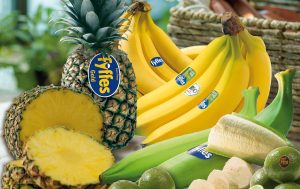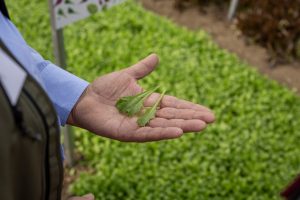At the end of last year, Syngenta held some field days to show its first solutions against the greatly feared Tomato brown rugose fruit virus (ToBRFV) and today they have 10 varieties available with intermediate resistance (IR) that give “verifiable results”, in addition to another four that we will detail for the first time in Fruit Today.
This virus has become the No. 1 top priority at Syngenta due to its importance in the main production areas, as they show with the abundance of solutions that they have put at the service of the sector.
Since the appearance of the virus was determined for the first time, the company has got down to work to find solutions, and Rafael Salinas, Head of Tomato for Spain and Portugal, explained to Fruit Today that in recent months they have taken a step further in their work with the evaluation and introduction of materials with resistance to ToBRFV. “Unfortunately, in the croplands of Murcia and Almeria the virus has increased its presence,” he comments. In order to tackle this problem, at Syngenta they are working with genetically tested material and they verify the behaviour of the plant after infecting it in phytotron conditions, and then on adult plant crops, an essential aspect to determine how it develops and what symptoms a variety shows against an attack by ToBRFV.
The first commercial and pre-commercial materials from Syngenta have IR to ToBRFV, which in high pressure conditions can present some symptoms, but much fewer than in other varieties. “The difference is considerable compared to sensitive materials.” Parallel to this, they are working to find a high, long-lasting resistance “in case the virus were able to mutate over time.”
The two latest developments that the company has developed are two orange plum cherry tomatoes, and they have another two materials under development in the plum tomato typology, very similar to Caniles, with the same format, production and quality, which will move on to a pre-commercial phase in the autumn, Salinas advanced to Fruit Today.
They already have four red plum cherry tomatoes in the pre-commercial phase that have IR to ToBRFV, which are being introduced and positioned for different dates and areas (from Costa de Granada to Alicante): TIPM 22-6004; TIPM 22-6001 and TIPM 22-6003 that also include IR to TYLCV; and TIPM 22-6002 with HR to TYLCV.
Extensive offer in large calibres
In the sales catalogue, the first variety with resistance launched by the company is Ibeth, a G-GG salad tomato with IR to ToBRFV. The fruit have a flattened shape; they are very uniform and have a very bright red colour. The variety is adapted to early production cycles and also for slightly later cycles, from the middle to the end of August.
In Beefsteak tomatoes, Vitellio also has IR to TYLCV and ToBRFV, in addition to HR to spotted and resistance to TSWV. “We are trying to develop material with top resistance levels because ToBRFV has a strong interaction with the plant’s defences and when it becomes weakened, this can mean other viruses and diseases may attack it.”
Vitellio offers GG calibre with very attractive, flat fruit, with an intense deep red, as well as a good colour when green. Recommended for plantations similar to Ibeth, Vitellio stands up to the winter well and it can be planted in August and September for autumn plantations and from December to February for spring plantations in Almeria and Murcia. This year it will be tested under netting from May to July in Murcia.
For export crops in Murcia, Syngenta offers Lansor and Barosor, with a more intermediate calibre. Both are highly productive, with many pieces per branch and they can be used for all dates.
Regarding resistances, they have IR to TYLCV and ToBRFV; HR to spotted and resistance to TSWV, as well as to nematodes (for some areas without grafting), offering important healthiness to the plant.
Also for Murcia, they are offering Waqu (G). Although it is adapted to plantations throughout the entire year, its main focal point is the summer months (from April to August), as it is very well adapted to conditions of particularly extreme heat, under netting. Highly productive, it has a very hardy plant, IR to TYLCV and TSWV.
In G vine tomatoes, they have 121038, which are closely in line with what the market is seeking: bright red fruit, very clean and highly tolerant to micro-cracking. It is focused on plantations from mid-August to mid-September. The variety is very productive; it has very good flowering, very good setting and good calibre throughout the cycle. Regarding resistances, it has IR to TYLCV and ToBRFV.
The new developments in plum tomatoes are Numenor (SD 12018) and Valinor (SD 2101). Numenor, M calibre, heart-shaped, with great capacity for setting in heat, does not split, nor does it form points or spotting. It is very productive and it has resistance to spotted, yellow powdery mildew, TYLCV and ToBRFV.
Valinor has G calibre (120-130 gr) and is longer in shape. Its plant is very healthy; it works well either under netting or under plastic, with the months from May to July standing out under netting and from the beginning to the end of August.























